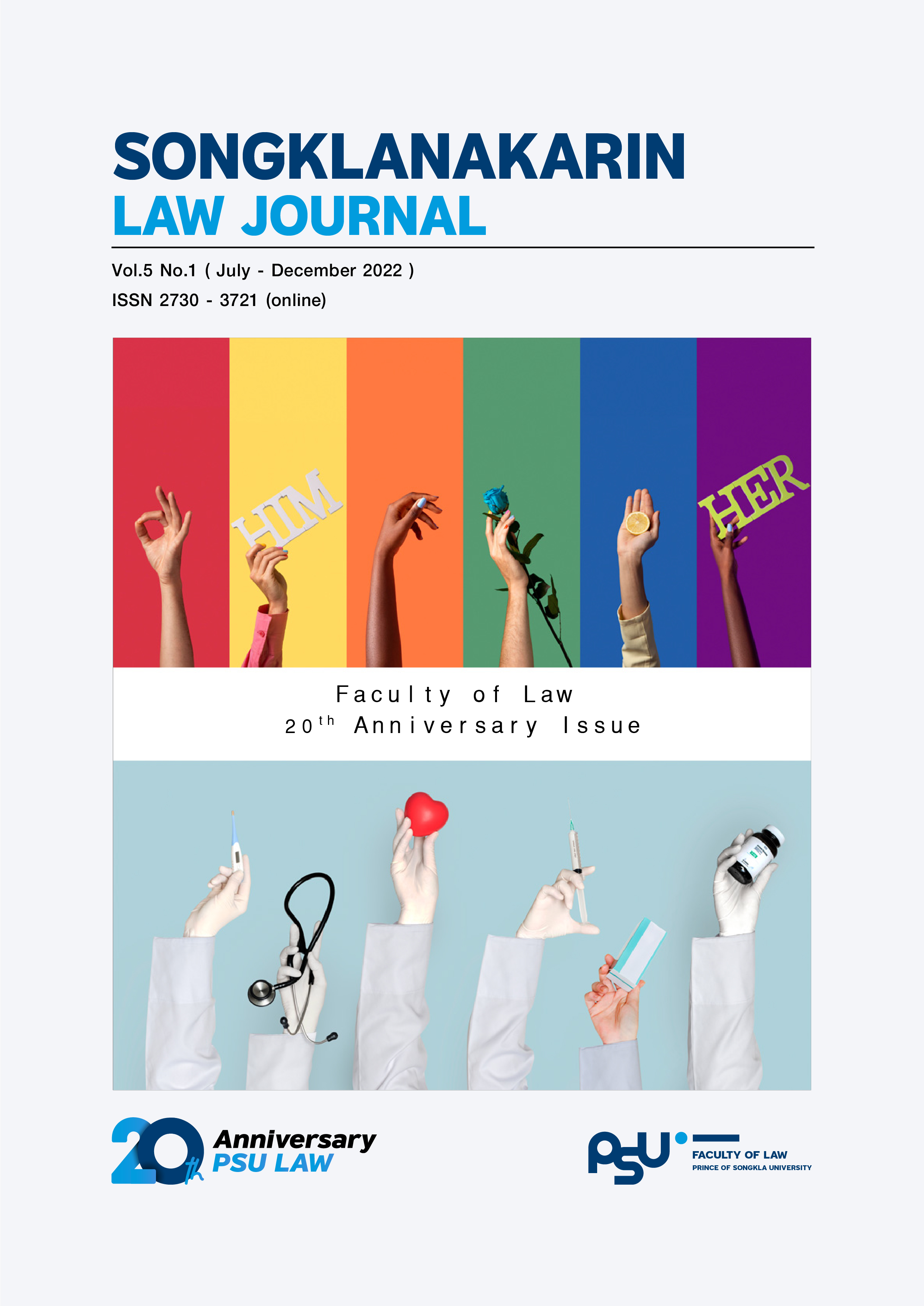แนวทางการรับรองสิทธิในอัตลักษณ์ทางเพศของประเทศไทยผ่านมุมมองของกฎหมายต่างประเทศ
คำสำคัญ:
สิทธิมนุษยชน , อัตลักษณ์ทางเพศ , การรับรองทางกฎหมายบทคัดย่อ
บทความวิจัยเรื่องนี้มุ่งศึกษาแนวทางการรับรองสิทธิในอัตลักษณ์ทางเพศของประเทศไทยผ่านมุมมองของกฎหมายต่างประเทศ โดยศึกษาด้วยวิธีการวิจัยเอกสาร (Documentary Research) จากตำรากฎหมายและเอกสารต่าง ๆ ที่เกี่ยวข้องกับการรับรองอัตลักษณ์ทางเพศของกลุ่มบุคคลบนพื้นฐานของความหลากหลายทางเพศในกฎหมายสิทธิมนุษยชนระดับสากลและกฎหมายของต่างประเทศ ผลจากการศึกษาพบว่า ภายใต้หลักสิทธิมนุษยชนสากล รัฐต่าง ๆ ย่อมมีหน้าที่รับรองสถานภาพทางกฎหมายตามอัตลักษณ์ทางเพศที่บุคคลพึงประสงค์ เพื่อให้บุคคลนั้นสามารถในการใช้สิทธิต่าง ๆ บนพื้นฐานของอัตลักษณ์ทางเพศที่กฎหมายให้การรับรอง โดยห้ามกำหนดเงื่อนไขที่มีลักษณะเป็นการละเมิดสิทธิมนุษยชนในเรื่องอื่น ๆ เพื่อให้ได้มาซึ่งการรับรองสถานภาพทางกฎหมาย ปัจจุบันประเทศไทยมีเพียงการรับรองสถานภาพทางกฎหมายของบุคคลซึ่งจำแนกตามเพศชายและเพศหญิงเท่านั้น ส่งผลทำให้บุคคลซึ่งมีความหลากหลายในอัตลักษณ์ทางเพศได้กลายเป็นกลุ่มเป้าหมายจากการถูกเลือกปฏิบัติโดยไม่เป็นธรรมในพื้นที่สาธารณะอย่างกว้างขวาง ดังนั้น จึงสมควรมีกฎหมายเพื่อกำหนดหลักเกณฑ์ เงื่อนไข และผลในทางกฎหมายของการรับรองอัตลักษณ์ทางเพศตามเจตจำนงของบุคคลเหล่านั้น อันเป็นการสอดคล้องกับหลักการสิทธิมนุษยชนสากลตามพันธกรณีระหว่างประเทศที่ประเทศไทยเข้าเป็นภาคี
เอกสารอ้างอิง
ไพศาล ลิขิตปรีชากุล (ผู้แปล) (2551). หลักการยอกยาการ์ตาว่าด้วยการใช้กฎหมายสิทธิมนุษยชนระหว่างประเทศในประเด็นวิถีทางเพศและอัตลักษณ์ทางเพศ. พิมพ์ครั้งที่ 1 กรุงเทพฯ : สำนักงานคณะกรรมการสิทธิมนุษยชนแห่งชาติ.
อารยา สุขสม (2559). สิทธิมนุษยชนในเรื่องวิถีทางเพศและอัตลักษณ์ทางเพศในระบบกฎหมายไทย, (วิทยานิพนธ์ดุษฎีบัณฑิต คณะนิติศาสตร์ มหาวิทยาลัยธรรมศาสตร์).
อารยา สุขสม. (2563). คู่มือปฏิบัติงานของหน่วยงานและเจ้าหน้าที่ในการคุ้มครองความเท่าเทียมระหว่างเพศตามพระราชบัญญัติความเท่าเทียมระหว่างเพศ พ.ศ. 2558, โครงการพัฒนาแห่งสหประชาชาติ (UNDP).
Committee on Economic Social and Cultural Rights, Concluding observations on Germany, E/C.12/DEU/CO/5, 20 May 2011.
Dunne, Peter R., and Clark, Stephen. (2019). Comparative Legal Review of Gender Recognition Laws Across the Commonwealth. London: Equality & Justice Alliance.
Holzer, Lena. (2018). Non-Binary gender registration models in Europe report on third gender marker or no gender marker options. ILGA Europe.
Human Rights Committee. Concluding observations on Ireland. CCPR/C/IRL /CO/3, 30 July 2008.
Human Rights Council. Report of the Office of the United Nations High Commissioner for Human Rights, Discriminatory laws and practices and acts of violence against individuals based on their sexual orientation and gender identity. A/HRC/19/41, 17 November 2011.
International Commission of Jurists. (2009). Sexual Orientation, Gender Identity and International Human Rights Law: Practitioners Guide No. 4. Geneva: International Commission of Jurists.
Report of the Special Rapporteur on violence against women. its causes and consequences. Addendum: Mission to Kyrgyzstan. A/HRC/14/22/Add.2, 28 May 2010.
Richardson, Diane. (2000). Constructing Sexual Citizenship: Theorizing Sexual Rights. Critical Social Policy, 20(1), 105-135.
Shaman, Jeffrey. M. (2008). Equality and Liberty in the golden age of state constitutional law. New York: Oxford University Press.
The Yogyakarta Principles on the Application of International Human Rights Law in Relation to Sexual Orientation and Gender Identity (2007)
The Yogyakarta Principles plus 10: Addition principles and state obligations on the application of international human rights law in relation to sexual orientation, gender identity, gender expression and sex characteristics to complement the Yogyakarta principles. (2017)
United Nations Development Programme (UNDP) (2013). Discussion Paper Transgender Health and Human Rights. New York: United Nations Development Programme.
World Health Organization. (2018). ICD-11 Conditions related to sexual health (17).
ดาวน์โหลด
เผยแพร่แล้ว
ฉบับ
ประเภทบทความ
สัญญาอนุญาต
ลิขสิทธิ์ (c) 2022 วารสารกฎหมายสงขลานครินทร์

อนุญาตภายใต้เงื่อนไข Creative Commons Attribution-NonCommercial-NoDerivatives 4.0 International License.
ลิขสิทธิ์ในบทความที่ตีพิมพ์เผยแพร่เป็นของวารสารกฎหมายสงขลานครินทร์ วารสารกฎหมายสงขลานครินทร์มีสิทธิในการเผยแพร่ ทำซ้ำ หรือรวบรวมบทความที่ตีพิมพ์เผยแพร่แล้ว ความคิดเห็นใด ๆ ของผู้เขียนในบทความ กองบรรณาธิการวารสารไม่จำเป็นต้องเห็นพ้องด้วย ทั้งนี้กองบรรณาธิการวารสารไม่สงวนสิทธิในการคัดลอกแต่ให้อ้างอิงแหล่งที่มาด้วย



